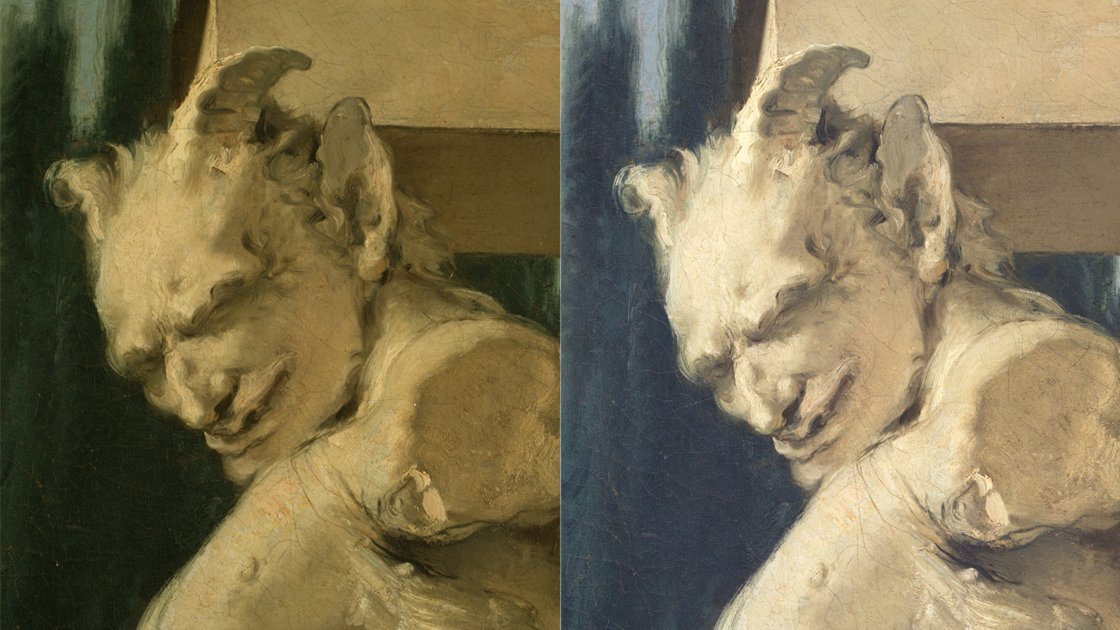Restoration and technical study
This display shows the results obtained at the museum’s laboratory using various study techniques such as X-radiography (X-ray), infrared photography (IR-reflectography) and the analysis of materials based on the microsamples taken.
This process proved essential to identifying the artist’s execution technique and the composition of the painting materials, as well as their distribution in the various strata of the work.
The restoration of The Death of Hyacinthus has been focused chiefly on the complex task of removing the successive layers of discoloured varnish and grime that had built up over time. Cleaning has returned the aesthetic unity and the vibrant, richly hued colours of the original painting.
The picture can be seen in room 17 of the museum from 23 June to 14 January 2018 alongside X-radiographs and infrared reflectograms showing the work carried out; also on view together with the technical materials are two drawings by Tiepolo, lent by the Staatsgalerie in Stuttgart, in a display put together by the departments of Conservation/Restoration and Old Master Painting.

The restoration process
The treatment performed basically entailed using solvents for the controlled removal of the varnishes that had been applied at different points in the picture’s history and the overpaint added in the past to conceal small losses of paint.
A study of the layers of varnish revealed the presence of remains of early varnishes distributed very unevenly in various parts of the painting. Traces of rosin, shellac, acrylic resin and dammar were detected. The final coating was dammar, which had turned yellow, significantly obscuring the painting’s appearance.
This uneven distribution indicated that previous cleaning operations had been carried out in an equally uneven manner: that is, concentrating on the pale areas and barely touching the dark areas in order to emphasise the contrast between light and shade, in keeping with old-fashioned criteria. This method had caused an imbalance in the conception of the colour of the composition and in the depth of all the elements depicted in this painting. We ended by adding a ketone resin retouching varnish, applying the initial coating with a brush and the final coating with a spray.



The work performed has restored much of the hidden splendour of this magnificent picture in which the artist spared no expense on high quality painting materials and carefully planned and prepared the composition before putting his brush to the canvas, displaying a mastery consonant with his experience and skill.
Reintegration was carried out in accordance with the established protocols that involve an initial technical study and direct intervention with the support and monitoring of the chemical analysis laboratory. Lastly, the losses in the ground layer were filled and the paint film was reintegrated firstly with watercolours and subsequently by applying a finish using pigments in varnish in specific areas of wear or loss.
X-Radiography
X-radiography allows us to view the changes Tiepolo made during the process of creating the picture.
Some of the most notable are in the left-hand side, where the artist modified the king’s position by turning him to face the main scene. This also involved changing the folds of his robes and arm. Behind him Tiepolo added the figure of a soldier and varied the size and shape of both their hats. In the lower part we can see that the straps of the quiver were initially longer. The figure of the child, unlike the rest, is not visible in the X-ray image as it was executed using pigments through which radiation passes more easily.



Tiepolo worked more confidently in the right-hand part of the picture, positioning the main figures more firmly and making hardly any changes. Minor alterations can be seen in the placement of Hyacinthus’s arm and also in Apollo’s thumb, whose position is interpreted as an erotic allusion aimed at viewers. Apollo’s knee, on which Cupid leans, was slightly displaced so that Cupid’s left hand is now suspended in the air.
Visible in the background is the sketch of what is possibly a mountain and various buildings. They were covered by vegetation and clouds in the final painting to create a sensation of greater space.
Analysis of the materials

Blue of Apollo’s cloak: Apollo’s blue cloak was executed in a paint film with large grains of lapis lazuli in a matrix of lead white and calcium carbonate. This layer was applied over a lighter blue, uniform base achieved by mixing indigo and lead white. The uneven thickness of all the blue layers, their blending in places and the purity of the chosen pigments made it possible to obtain the blue hues of Apollo’s mantle. The binder employed in these paint layers is also linseed oil. The sequence of brushstrokes and the distribution of the materials found in them are consonant with the characteristics studied in the cross-section of Apollo’s flesh, and are more different to those found in the microsample taken from the leg of the girl on the left of the scene.
Infrared reflectography
Infrared reflectography reveals the preparatory drawing or sketch concealed beneath the paint layers. It shows how the artist gradually made various changes to the composition, some of which are also visible in the X-ray image.
Hyacinthus’s father Amyclas, king of Sparta, appears with a cloth headdress which was subsequently replaced with a cap; his right hand displays a few rectifications or hesitations with respect to its final position.
In the drawing the god Apollo is shown with ornaments (an earring and a ribbon with a pearl) which were later painted over. His left thumb was not originally superimposed on top of the figure of the god Pan as it is now. Traces of a drawing can also be glimpsed showing Apollo’s knee in a higher position and touching Cupid’s left hand.
Finally, the position of the cloth on Hyacinthus’s leg was altered slightly.










